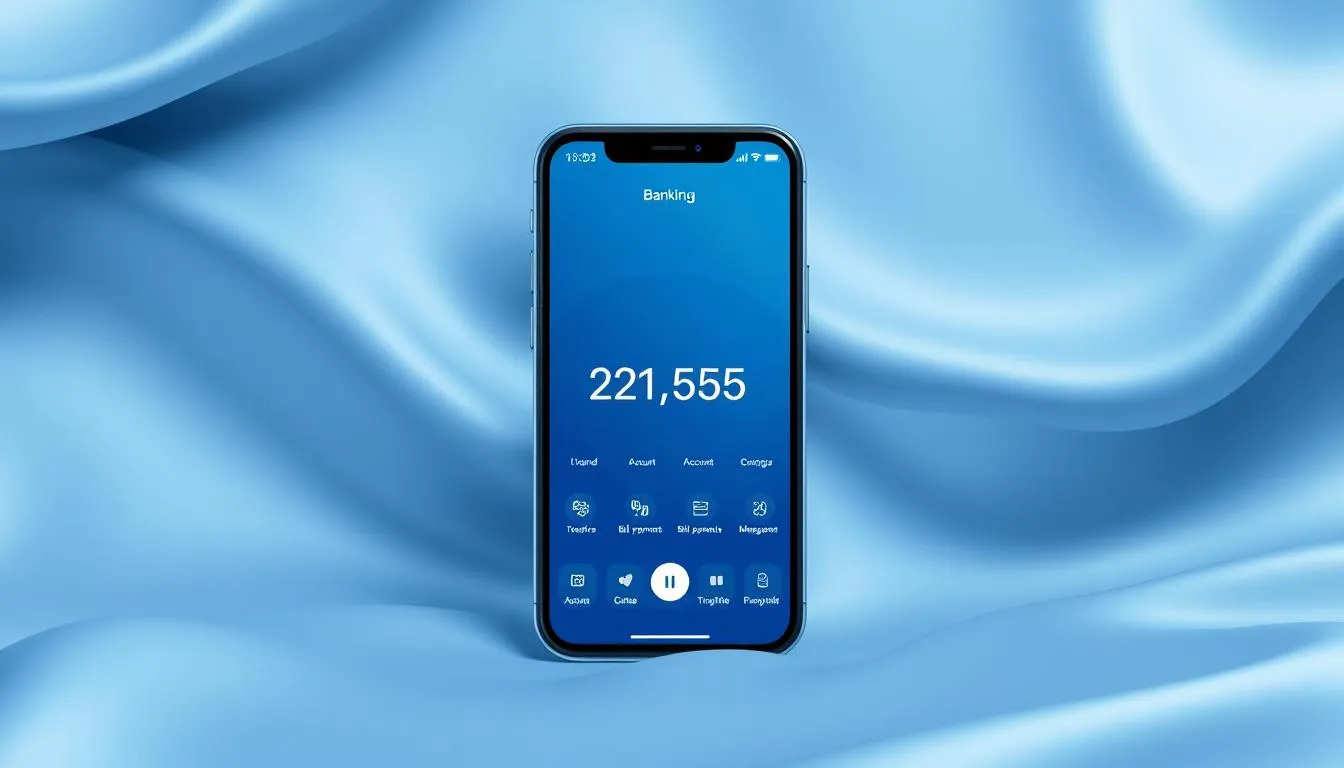Surprising stat: more than 76% of Americans use mobile apps for banking, and globally 1.75 billion online accounts move about $1.4 trillion each year.
This short guide explains how digital banks and modern online banking options shape the U.S. market today. You’ll see how winners like Discover—praised for a high-yield savings account and cash-back checking—fit into a larger shift toward API-rich platforms and real-time payments.
We focus on what matters to consumers: account types, payments, security, and AI tools. Expect clear comparisons of online banking services and real examples from Bank of America and DBS that show top-tier execution.
Use this guide to weigh the key benefits and trade-offs so you can pick the right banking experience without unnecessary fees. For a quick primer on what this change means, read what is digital banking.
Key Takeaways
- Most Americans use mobile apps, making online banking central to everyday finance.
- High-yield accounts and fee-free checking can be major advantages for consumers.
- API integration and instant payments drive faster, richer services behind the scenes.
- Compare accounts by payments, security, fees, and AI features to match your needs.
- Branch closures and global adoption mean the landscape will keep evolving.
What makes a bank “digital” in the first place?
A true online-first bank retools products and processes so customers can complete every action without a branch visit.
digital banking digitizes core products and workflows so people can open accounts, move money, pay bills, and get support entirely through web or mobile channels.
By contrast, online banking often delivers a subset of those transactional functions via a browser. A mobile banking app is the smartphone channel that lets you do the same tasks on the go.

Types you’ll meet
- Neobanks: operate mainly online and often partner with licensed providers.
- Challenger banks: newer entrants that aim to beat incumbents on fees or UX.
- Fully licensed new banks: examples include Revolut, Monzo, N26, and Starling — full-service, app-first providers.
| Model | License | Typical services | Customer access |
|---|---|---|---|
| Neobank | Partner license | Checking, cards, basic transfers | App/web only |
| Challenger | Own license (varies) | Expanded accounts, new features | App-first, fast releases |
| Fully licensed new bank | Own bank license | Full retail services, savings, FX | Complete online access |
Why it matters: API-first technology speeds feature delivery and integrations. Look for secure login, smooth UX, and quick support as the best “smell tests” of a true digital model.
The state of digital banking today in the United States
Everyday money management has moved into apps and websites. More than three out of four Americans now manage accounts with a mobile banking app, which makes app-first features the new standard for customer experience.
Present-day adoption: Over 76% of Americans use mobile banking apps
Adoption is mainstream today. Over 76% of American customers use mobile apps, so routine tasks—checking balances, moving funds, and paying bills—happen on phones more than ever.

Branch closures and the shift to online banking services
Physical footprints are shrinking. Since 2018, the U.S. has averaged about 1,646 branch closures per year, which pushes more activity into online banking and in-app workflows.
- Global scale: 1.75 billion accounts handle roughly $1.4 trillion a year.
- Efficiency gains: many banks report 20%–40% cost reductions by automating and cutting locations.
- What this means for customers: faster account opening, richer app features, and higher expectations for fast support and secure services.
For people choosing providers today, look beyond rates. Evaluate app reliability, support speed, and how actively a bank rolls out new mobile features. Those factors often tell you more about future value than branch access.
Trends shaping digital banking right now
Modern trends are reshaping how people move money, use apps, and interact with account services.
AI-enabled personalization has moved past back-office risk scoring. Banks now use models to send smart nudges, speed applications, and predict cash flow. TD Bank, Isbank, and Tatra banka show how these tools cut friction and raise satisfaction.
APIs and open banking
Open APIs are unlocking embedded services and faster payments. DBS offers hundreds of corporate APIs and RAPID modules for real-time receivables. Bank of America’s CashPro API uptake shows companies prefer flexible routing by cost or speed. Citi’s cloud-native platform adds programmable payment tools for enterprise liquidity.
Mobile-first experiences
More activity lives in apps, so UX, instant rails, and payment automation are central. Customers get less waiting, fewer steps, and better money management tools.

| Trend | Customer impact | Real example |
|---|---|---|
| AI personalization | Faster onboarding, tailored nudges | TD Bank, Tatra banka |
| API platforms | Real-time payments, embedded services | DBS, Bank of America |
| Mobile-first payments | Lower friction, instant rails | CitiToken/CitiDirect |
Digital banks to consider today
If you’re shopping for modern account features, a few standout providers set the pace today.
Discover earned NerdWallet’s 2025 Best Online Banking Experience. Its high-yield savings, cash-back checking with no monthly fees, and wide CD range make it ideal for consumers focused on returns and simple accounts.
TD Bank won North America’s Best Consumer Digital Bank. The company uses AI nudges and generative tools to speed routine tasks and improve in-app outcomes for customers.
Bank of America pairs a leading integrated consumer site with expanded CashPro APIs, showing depth across retail services and corporate clients.
Citi ranks top for corporate and institutional needs. Tools like CitiDirect and Citi Token Services enable programmable payments and global liquidity for large clients.
Revolut, Monzo, and N26 focus on robust apps and fast feature releases, appealing to users who want agile interfaces and broad product suites.
Bank of Georgia and DBS stand out for personalization and platform thinking. Bank of Georgia uses machine learning to tailor experiences, while DBS offers 280+ corporate APIs and modular RAPID services for real-time capabilities.
When comparing providers, match accounts and app needs to the services that matter most to you.
Features and tools to compare across digital banking apps
Start by checking which services make moving money, tracking spending, and staying secure easy and predictable.
Accounts and payments
Compare checking, savings, bill pay, external transfers, and speed. Look for daily limits, fees, and how fast payments clear. Some providers let you route transfers by cost or speed.
Security and compliance
Check for multi-factor authentication, biometrics, and transaction monitoring. Award-winning information security and fraud management matter for peace of mind.
Spending insights and cash-flow tools
Evaluate predictive features that help with money management. Tatra banka’s Spending Plan uses machine learning to forecast recurring payments and warn you about shortfalls. TD Bank and Isbank add AI nudges and SME cash forecasts.
APIs, integrations, and real-time capability
For advanced use, prefer a robust platform with APIs. Bank of America saw CashPro API uptake rise 51%. DBS offers 280+ APIs and RAPID modules for real-time payment, receivables, and information flows—useful for scaling small business needs.
| Feature | What to check | Example |
|---|---|---|
| Accounts & payments | Speed, limits, fees, bill pay | Fast transfers, clear fee table |
| Security | MFA, biometrics, fraud alerts | Awarded systems, strong monitoring |
| Spending tools | Forecasts, category insights, nudges | Tatra banka, TD Bank features |
| APIs & integrations | Real-time rails, connectors, roadmap | DBS 280+ APIs, CashPro growth |
The consumer benefits of going fully digital
Going fully digital changes how customers save time and cut costs in everyday banking. Providers that digitize core services report 20%–40% lower operating costs. That helps lower fees and speed up service for consumers.
Accounts open faster and routine tasks happen any time without branch visits. Customers get clearer pricing and fewer service delays.
Personalized nudges, budgeting, and goal tracking
AI nudges from firms like TD Bank and Tatra banka’s spending plan give tailored prompts. These tools warn about bills, suggest savings, and keep goals on track.
Innovation extras: contactless payments to investing features
Apps now bundle contactless payments, card controls, and optional investing. Many services even offer access to crypto or commodities alongside standard accounts.
| Benefit | Consumer impact | Example |
|---|---|---|
| Lower fees | More competitive pricing, fewer account costs | 20%-40% ops cost reduction |
| 24/7 access | Open accounts, move cash, manage tasks anytime | App-based account opening |
| Personalization | Better spending control, goal tracking | TD Bank AI nudges; Tatra banka ML plan |
- Better customer experience comes from simpler flows and faster updates.
- Competition drives faster feature releases and more choice for consumers.
How to choose and get started with a digital bank
Start by deciding what you need from an online account and which features matter most to your daily money habits.
Match features to your needs: list the accounts you use, typical balances, direct deposit timing, card usage, and how often you need live support.
Match features to your needs: Fees, yields, app UX, and support
Compare product details like fees, ATM access and reimbursements, APYs on savings, and CD terms. Discover is a useful benchmark because it offers high-yield savings, cash-back checking with no monthly fees, and a range of CDs.
Test the app experience hands-on. Sign up for previews or demos, read recent user feedback, and confirm how support is delivered—chat, phone, or limited hours.
Decide how fast you want access. Many providers allow same-day setup with streamlined KYC so you can move money and try features right away.
- Look for a clear product roadmap and frequent updates that show responsiveness to customer needs.
- If you run a small business, verify APIs and advanced apps to avoid switching later; institutions like Bank of America, Citi, DBS, and Bank of Georgia show varied strengths across UX and platform depth.
- Narrow your shortlist by reliability, transparent terms, and how each bank positions itself in the market.
| Decision step | What to check | Why it matters |
|---|---|---|
| Needs checklist | Accounts, balances, deposit timing, card habits | Matches product fit to daily use |
| Fees & yields | Monthly fees, APYs, CD terms, ATM reimbursements | Impacts long-term savings and cost |
| App & support | User reviews, demo access, support channels | Affects usability and issue resolution speed |
| Speed & roadmap | Same-day access, update cadence, API availability | Signals future features and scale |
For a quick primer on what this change means, read what is digital banking.
Conclusion
Today’s account choices reward speed, clear terms, and apps that actually simplify money tasks. Use award winners and platform leaders—like Discover, Bank of America, Citi, DBS, TD Bank, and Bank of Georgia—as benchmarks for performance and support.
Focus on fit: compare product scope, payment speed, API support, and the overall customer experience against your needs. Leaders pair AI, real-time payments, and APIs to cut friction and raise efficiency.
Expect steady innovation over the next months and year. With more competition, consumers can find fully digital solutions that match everyday management and business needs. Pick a provider with clear terms, reliable service, and a strong app to keep your finances simpler and smarter.
FAQ
What is a digital bank and how does it differ from traditional banks?
A digital bank delivers financial services primarily through mobile apps and online platforms rather than via physical branches. It focuses on streamlined customer experience, faster payments, and tools like budgeting, spending insights, and real‑time notifications. While traditional banks still rely on branch networks and in‑person service, a modern online bank emphasizes technology, API integrations, and efficiency to meet consumer needs 24/7.
How is online banking different from mobile banking and neobanks?
Online banking typically refers to web‑based account access, while mobile banking centers on smartphone apps and mobile features such as contactless payments. Neobanks are often app‑first challengers that may operate under their own banking license or partner with licensed banks to provide accounts and payment services. All three use technology to improve service, but they vary in licensing, product range, and platform integrations.
Are neobanks and challenger banks safe to use for everyday accounts?
Many neobanks partner with established, regulated banks or hold full banking licenses, which means deposits can be protected by standard insurance schemes like the FDIC when applicable. Security measures commonly include multi‑factor authentication, fraud detection, and encryption. Always check a provider’s regulatory status, insurance coverage, and information security practices before opening an account.
What features should I compare when choosing an online or app‑first bank?
Compare checking and savings yields, monthly fees, bill pay and ACH transfer limits, payment options (including real‑time and contactless), mobile app usability, customer support channels, and security protocols such as KYC/AML and fraud management. Also consider integrations and APIs if you need accounting or business tools, plus spending analysis or AI‑driven insights for personal finance.
How common is mobile banking use in the United States today?
Mobile banking use is widespread: over three‑quarters of Americans now use mobile apps to manage accounts, pay bills, and transfer money. This adoption drives banks to prioritize mobile‑first experiences, faster payments, and services that meet consumers’ expectations for convenience and speed.
Do online banks offer business services and cash‑management tools?
Yes. Many platform‑focused providers and established banks offer business accounts, payroll integrations, cash‑management features, invoicing, and APIs for embedded financial services. Corporate clients can access treasury tools, real‑time payments, and reporting to streamline operations and improve cash flow management.
How do modern banks use AI to improve customer experience?
Banks deploy AI for personalization, spending categorization, predictive budgeting, fraud reduction, and automated support via chatbots. AI can surface tailored offers, detect unusual activity faster, and generate insights that help customers meet savings or investment goals while improving operational efficiency for the bank.
What are the main security and compliance measures to look for?
Key measures include strong encryption, multi‑factor authentication, continuous fraud monitoring, clear KYC/AML processes, and regulatory compliance filings. Look for published security practices, transparent privacy policies, and certifications or third‑party audits that demonstrate robust information security and risk management.
Can I move my direct deposits and bill payments to a new online bank easily?
Yes. Most banks provide step‑by‑step guides to transfer direct deposits, automate bill payments, and set up recurring transfers. Use account aggregation tools or downloadable transaction histories to reconcile automatic payments and ensure a smooth transition without service interruptions.
Which brands are recognized for strong online banking experiences?
Well‑known names with strong digital offerings include Bank of America and Citi for integrated consumer and corporate services, TD Bank for consumer digital recognition in North America, DBS for API richness and mobile capabilities, and specialty providers like Revolut, Monzo, and N26 for compelling app‑first experiences. NerdWallet and other reviewers publish yearly rankings that can help compare options.
How do APIs and open banking change the way I use financial services?
APIs enable faster payments, embedded financial services, and seamless integrations with accounting software, payment platforms, and fintech tools. Open banking gives consumers more control over data sharing, letting third‑party apps securely access account information to offer personalized budgeting, lending, and investment services.
Are fees generally lower with online banks?
Many app‑first providers and fully online institutions offer lower monthly fees and higher yields because they save on branch overhead. However, fee structures vary: check for ATM reimbursement, international fees, overdraft policies, and charges for wire transfers or premium tools to assess true cost benefits.
What should I know about privacy and data sharing with app‑based financial services?
Review a provider’s privacy policy to understand what data they collect and how they share it. Reputable platforms disclose third‑party integrations, data retention practices, and opt‑out options. When using budgeting or comparison apps, ensure data access uses secure APIs and that you control permissions for account information.
How do spending insights and cash‑flow tools help everyday consumers?
These tools categorize transactions, highlight recurring subscriptions, and forecast balances to prevent overdrafts. AI‑powered nudges and goal tracking simplify saving and reduce financial stress by offering actionable recommendations tailored to your income and spending patterns.
What are the limitations of going fully online for banking?
Limitations include reduced access to in‑person services like safe‑deposit boxes or complex advisory meetings, potential challenges with cash deposits, and reliance on internet access. For businesses or customers who need physical services, a hybrid approach with a traditional provider may be preferable.
